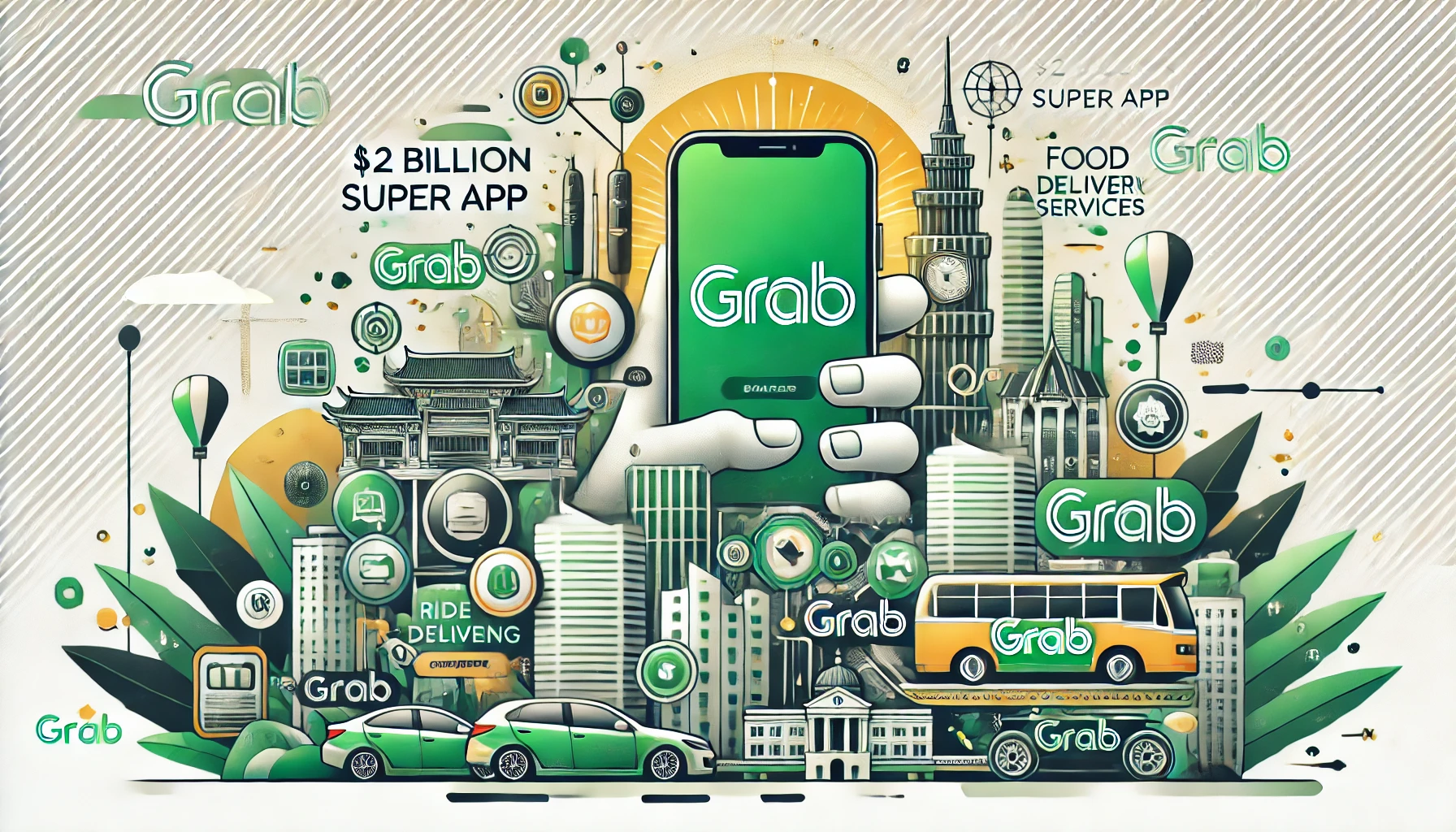Meet Anthony Tan: The Visionary Behind Grab’s $2 Billion Super App and Its Innovative Business Model
Building a company from scratch is no easy task, but taking that company to a valuation of over $2 billion a year? That’s an entirely different level of achievement. Anthony Tan, the 42-year-old co-founder and CEO of Grab, has managed to do exactly that. Under his leadership, Grab has transformed from a simple ride-hailing service into a full-fledged super app that serves millions across Southeast Asia. From Grab’s IPO to its expansion into food delivery and financial services, this article explores how Anthony Tan and his team turned Grab into a multi-billion-dollar business powerhouse.
In this blog post, we’ll dive into how Tan’s leadership and Grab’s business model have redefined the Southeast Asian tech landscape. We’ll also take a closer look at the company’s diverse revenue streams, its growth trajectory, and its future outlook in an increasingly competitive market.
The Rise of Grab: From Ride-Hailing to Super App
Grab was launched in 2012 as a ride-hailing service, initially aimed at competing with Uber in Southeast Asia. However, under Anthony Tan’s vision, Grab quickly pivoted to offer a wider array of services, positioning itself as a super app. Today, Grab’s services span multiple industries, including transportation, food delivery, digital payments, and financial services, making it a one-stop-shop for everyday needs in Southeast Asia.
Grab’s super app model allows users to perform various tasks all within one platform, including booking rides, ordering food, paying bills, and even accessing insurance and financial services. This approach has been critical to its success, allowing it to establish a massive user base in countries like Singapore, Malaysia, Indonesia, and the Philippines.
What Makes Grab a Super App?
Grab’s transition from a ride-hailing service to a super app is a key factor behind its meteoric rise. The Grab super app integrates multiple verticals, giving users access to services ranging from transportation and food delivery to financial services like digital wallets and loans. By offering a diverse array of services, Grab has ensured that users engage with the platform daily, thus increasing user loyalty and retention(productmint).
Another significant advantage of this model is its ability to leverage data across all services to enhance customer experience. The company uses data from its ride-hailing service, GrabFood, and GrabPay to create personalized offers and recommendations for users, fostering greater engagement and customer satisfaction.
Anthony Tan: The Driving Force Behind Grab’s Success
Anthony Tan, a Harvard Business School graduate, co-founded Grab in 2012 with a vision to provide safer transportation solutions in Southeast Asia. Over time, his ambitions grew, and he transformed Grab into the multi-billion-dollar company it is today. His leadership has been instrumental in navigating the complexities of Southeast Asian markets and scaling the company to achieve its current valuation.
How Anthony Tan Built a $2 Billion Super App
Tan’s relentless drive and determination are well-documented. He famously spoke about working 20-hour days to ensure the success of Grab. His leadership style is often characterized by his ability to adapt to market changes and seize opportunities in different sectors(productmint).
Tan’s strategy to expand Grab into new areas such as Grab financial services and Grab food delivery has been crucial to its growth. For instance, in response to the COVID-19 pandemic, Grab ramped up its food delivery and digital payment services, which became a lifeline for many users during lockdowns. These timely moves helped the company weather economic challenges and maintain its growth trajectory(productmint).
Grab’s Business Model: Diverse Revenue Streams
One of the reasons for Grab’s financial success is its diversified business model. Unlike other companies that rely heavily on one source of revenue, Grab generates income from multiple verticals. Let’s break down the company’s key revenue streams:
1. Ride-Hailing Services
At the heart of Grab’s success is its ride-hailing platform. The company generates revenue by taking a percentage of the fare from each ride, which typically ranges from 15% to 20%. With millions of rides completed daily across Southeast Asia, this service remains a significant revenue driver(productmint).
2. GrabFood and Food Delivery
Grab’s food delivery service, GrabFood, has become one of the leading players in the region’s food delivery market. With millions of active users, Grab earns commissions from restaurants and delivery fees from customers. During the pandemic, this service saw substantial growth, contributing significantly to Grab’s overall revenue(productmint).
3. Financial Services: GrabPay and Beyond
Another crucial aspect of Grab’s business model is its financial services, particularly its digital wallet, GrabPay. Users can make cashless payments, transfer funds, and even invest through Grab’s financial platform. The company also offers loans and insurance products in partnership with financial institutions. These services generate additional revenue while increasing user retention(productmint).
By building out these varied services, Grab has created a resilient and adaptable business model capable of thriving in both strong and weak economic conditions.
Grab’s IPO and Financial Success
In 2021, Grab made headlines with its initial public offering (IPO), listing on the Nasdaq through a SPAC merger. The IPO valued Grab Holdings at a whopping $40 billion, making it one of the largest-ever listings of a Southeast Asian company. This monumental event underscored the company’s significant financial growth and potential(productmint).
The funds raised from the IPO have enabled Grab to further expand its services, particularly in fintech and cloud kitchens, positioning the company for continued growth in the years ahead. Grab Holdings revenue has continued to grow, with the company reporting billions in annual revenue driven by its diversified service offerings(productmint).
What’s Next for Grab: Expanding Beyond Southeast Asia?
With its stronghold on the Southeast Asian market, Grab is now eyeing further expansion. The company is exploring opportunities in new markets, including potential moves into areas like logistics, healthcare, and more advanced financial services. Additionally, Anthony Tan has expressed interest in deepening Grab’s involvement in sustainable solutions, such as green transportation and renewable energy initiatives.
However, despite Grab’s significant growth, challenges remain. The company faces stiff competition from other super apps and ride-hailing platforms like Gojek and Shopee, which are also expanding their services in Southeast Asia. Regulatory hurdles, such as those experienced during Grab’s IPO, are another concern, as the company continues to navigate the complex economic landscape of the region(productmint).
How Grab Became Southeast Asia’s Leading Super App
Anthony Tan and his team have built Grab into one of the most successful companies in Southeast Asia, and its journey is far from over. The super app model has allowed Grab to become an essential part of daily life for millions of users, providing everything from transportation and food delivery to financial services. Through strategic leadership, smart investments, and diversified revenue streams, Grab has positioned itself for continued success.
As Grab expands into new industries and markets, the company’s innovative business model and ability to adapt to changing consumer needs will continue to fuel its growth. Investors and users alike are eager to see what the future holds for this Southeast Asian tech giant.
For further insights on business success and economic growth, visit Regent Studies.
For more updates on Grab’s market performance and business ventures, you can explore more at ProductMint(productmint).



